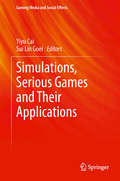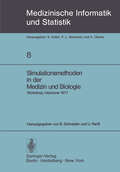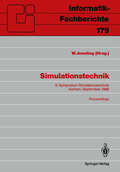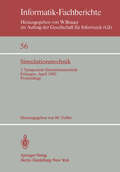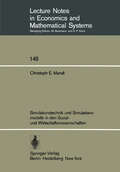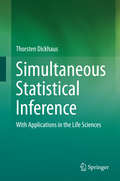- Table View
- List View
Simulation von Röhrenverstärkern mit SPICE: PC-Simulationen von Elektronenröhren in Audioverstärkern
by Alexander PotchinkovAudio-Röhrenverstärker erfreuen sich wachsender Beliebtheit im Hochpreissegment. Die Verfügbarkeit moderner Bauelemente, neue Schaltungskonzepte und die Erfahrungen aus dem Transistorverstärkerbau lassen das Interesse an Neu- und Weiterentwicklungen von Röhrenverstärkern steigen. Elektronikentwicklung mit Hilfe des universellen Schaltungssimulationsprogramms SPICE bilden eine vollkommene Einheit. Das Buch, einzigartig in diesem Bereich, will die Entwickler und die zahlreichen Amateure mit SPICE zusammenbringen. Das Buch hat drei Schwerpunkte: die Modellierung von Verstärkerröhren, die Anwendung von SPICE für die Untersuchung von Schaltungskonzepten und die Vorstellung moderner Schaltungstechniken, die mit SPICE analysiert werden können.
Simulation with Python: Develop Simulation and Modeling in Natural Sciences, Engineering, and Social Sciences
by Rongpeng Li Aiichiro NakanoUnderstand the theory and implementation of simulation. This book covers simulation topics from a scenario-driven approach using Python and rich visualizations and tabulations. The book discusses simulation used in the natural and social sciences and with simulations taken from the top algorithms used in the industry today. The authors use an engaging approach that mixes mathematics and programming experiments with beginning-intermediate level Python code to create an immersive learning experience that is cohesive and integrated. After reading this book, you will have an understanding of simulation used in natural sciences, engineering, and social sciences using Python.What You'll LearnUse Python and numerical computation to demonstrate the power of simulationChoose a paradigm to run a simulationDraw statistical insights from numerical experimentsKnow how simulation is used to solve real-world problems Who This Book Is ForEntry-level to mid-level Python developers from various backgrounds, including backend developers, academic research programmers, data scientists, and machine learning engineers. The book is also useful to high school students and college undergraduates and graduates with STEM backgrounds.
Simulationen in BASIC mit dem IBM PC, XT, AT: Astronomie, Biologie, Chemie und Dokumentationen (Vieweg-Programmbibliothek Mikrocomputer #39)
by Martin StumppSimulanten sind uns als Menschen bekannt, die durch "vorgespielte" Symptome den Eindruck erwecken wollen, an einer bestimmten Krankheit zu leiden. Der Simulant besitztdaherdas wichtigste Merkmal für den naturwissenschaftlichen Begriff Simulation, bei dem ebenfalls in Modellspielen mit einfachen Spielregeln die Realität imitiert wird. Ein Modell ist immer durch die Anzahl seiner Parameter begrenzt, kann also niemals allgemeingültig sein. Ausgehend von leicht zu durchschauenden Modellen aus den Themenkreisen Astronomie, Biologie, Chemie und Dokumentation von Ergebnissen sollen 22 kleine Anwendungen mit GW-BASIC und Lotus 1-2-3 vorgestellt werden. Simulation soll hier als Hilfsmittel für die Erstellung von Prognosen oder einfachen Spiel ergebnissen von Modellen obiger Themenkreise verstanden werden. Natürlich stellt der Abstraktionsumfang eines jeden Modells den begrenzenden Faktor für die Anwendung im Schulbereich dar, da diese Fähigkeit zur Abstraktion alters- und schultypabhängig ist: Doch auch dort, wo die natürlichen Modelle (Versuchstiere) unersetzbar sind, unterstützt der PC das "Erlebnis" am Tierversuch, wenn er eine übersichtliche und schnelle Versuchs auswertung liefert. Daher ist auch ein Programm, welches Realwerte liefert, in die Samm lung der Simulationsprogramme mitaufgenommen worden.
Simulations as Scaffolds in Science Education (SpringerBriefs in Educational Communications and Technology)
by Maggie Renken Melanie Peffer Kathrin Otrel-Cass Isabelle Girault Augusto ChiocarrielloThis book outlines key issues for addressing the grand challenges posed to educators, developers, and researchers interested in the intersection of simulations and science education. To achieve this, the authors explore the use of computer simulations as instructional scaffolds that provide strategies and support when students are faced with the need to acquire new skills or knowledge. The monograph aims to provide insight into what research has reported on navigating the complex process of inquiry- and problem-based science education and whether computer simulations as instructional scaffolds support specific aims of such pedagogical approaches for students.
Simulations for Design and Manufacturing: Select Papers from AIMTDR 2016 (Lecture Notes on Multidisciplinary Industrial Engineering)
by Uday S. Dixit Ravi KantThis book focuses on numerical simulations of manufacturing processes, discussing the use of numerical simulation techniques for design and analysis of the components and the manufacturing systems. Experimental studies on manufacturing processes are costly, time consuming and limited to the facilities available. Numerical simulations can help study the process at a faster rate and for a wide range of process conditions. They also provide good prediction accuracy and deeper insights into the process. The simulation models do not require any pre-simulation, experimental or analytical results, making them highly suitable and widely used for the reliable prediction of process outcomes. The book is based on selected proceedings of AIMTDR 2016. The chapters discuss topics relating to various simulation techniques, such as computational fluid dynamics, heat flow, thermo-mechanical analysis, molecular dynamics, multibody dynamic analysis, and operational modal analysis. These simulation techniques are used to: 1) design the components, 2) to investigate the effect of critical process parameters on the process outcome, 3) to explore the physics of the process, 4) to analyse the feasibility of the process or design, and 5) to optimize the process. A wide range of advanced manufacturing processes are covered, including friction stir welding, electro-discharge machining, electro-chemical machining, magnetic pulse welding, milling with MQL (minimum quantity lubrication), electromagnetic cladding, abrasive flow machining, incremental sheet forming, ultrasonic assisted turning, TIG welding, and laser sintering. This book will be useful to researchers and professional engineers alike.
Simulations in Swift 5: Design and Implement with Swift Playgrounds
by Beau NouvelleDesign and implement simulations using Apples Swift Playgrounds. Computer simulations are used to replicate the physical systems we see all around us. They help us solve problems by performing experiments that may otherwise be impossible in the real world. This book uses simulations to solve counter-intuitive logic puzzles, create procedural artworks, and build habitats for digital lifeforms. To help you create your own simulations using the Swift programming language, this book is filled with projects that you can easily follow along with. All you need is a Mac with the latest version of Xcode installed. All projects are written in Xcode’s Playgrounds. This keeps the process simple. No need to setup an Apple account, or learn anything further about building apps.Simulations are used in many areas within computer science and yet, barely anyone is teaching them. Sure, the fundamentals are in algorithm design, but simulations are a step above that. Usually when writing an algorithm you have a specific outcome in mind. However, when you create a simulation, the system you are modelling can be far more unpredictable than sorting a list, or navigating a maze. Simulations in Swift 5 will guide you through all of this.What You'll LearnSimulate situations with advanced algorithms to solve advanced problemsIncorporate real-world physics into simulated problemsPredict biological and other systems behavior and the outcome of events based on presented factorsWho This Book Is ForSwift programmers interested in tackling fun projects in Swift involving advanced algorithms and factors
Simulations of Decision-Making as Active Learning Tools: Design and Effects of Political Science Simulations (Professional and Practice-based Learning #22)
by Peter Bursens Vincent Donche David Gijbels Pieter SpoorenThis volume brings together both political and educational scientists. While educational research literature has so far not systematically addressed the tool of simulations of decision-making, political scientists have hardly used insights from research on assessment or on motivation and interest of students. Almost all political science publications on simulations merely discuss how to implement the tool in class and fall short of providing evidence of the effects on student outcomes such as increased interest and performance. Combining the two disciplines is mutually enriching. Political science benefits from state of the art educational science measuring and testing of the claims made by the proponents of simulations, while educational sciences adds the systematic analysis of simulations of decision-making to their list of empirical objects, which also adds insights to the theories on the affective component of student learning. It is the explicit aim of the volume to address how simulating decision-making environments fosters learning. Implications for research and practice regarding student learning are addressed in all chapters.
Simulations, Serious Games and Their Applications (Gaming Media and Social Effects)
by Yiyu Cai Sui Lin GoeiThis book presents the state of the art technology in Serious Games which is driven extensive by applications and research in simulation. The topics in this book include: (1) Fashion simulation; (2) Chinese calligraphy ink diffusion simulation; (3) Rehabilitation (4) Long vehicle turning simulation; (5) Marine traffic conflict control; (6) CNC simulation; (7) Special needs education. The book also addresses the fundamental issues in Simulation and Serious Games such as rapid collision detection, game engines or game development platforms. The target audience for this book includes scientists, engineers and practitioners involved in the field of Serious Games and Simulation. The major part of this book comprises of papers presented at the 2012 Asia-Europe Workshop on Serious Games and Simulation held in Nanyang Technological University, Singapore (May 9, 2012). All the contributions have been peer reviewed and by scientific committee members with report about quality, content and originality.
Simulationsbasierte Planungssysteme für Organisation und Produktion: Modellaufbau, Simulationsexperimente, Einsatzbeispiele
by Klaus Feldmann Gunther ReinhartDas Buch beschäftigt sich mit der Simulationstechnik, besonders der Ablaufsimulation in Organisation und Produktion. Im ersten Teil werden Erfolgsfaktoren und Hemmnisse beim Einsatz von Simulation beschrieben. Dabei werden unterschiedliche Simualtionsarten, konkrete Vorgehensweisen und mögliche Fehler aufgezeigt. Der Anwender erhält einen Überblick über Lösungswege und Anwendungshilfen. Im zweiten Teil werden zehn Praxisbeispiele vorgestellt. Sie gehen ein auf: - die Simulation bei Veränderungsprozessen (Ablaufsimulation in der Organisation) - die Simulation im betriebsbegleitenden Einsatz (Monitoring, Entstörung, Koordination) - die prozeßnahe Simulation (Optimierung von Steuerungssoftware, Anwendung von Neuronalen Netzen) - effiziente Modelle und Simulatoren (Referenzmodelle und teilautomatische Modellierung, modulare Simulationswerkzeuge).
Simulationsgestützte CAD/CAM-Kopplung für die 3D-Laserbearbeitung mit integrierter Sensorik (iwb Forschungsberichte #68)
by Helmut SchwarzSimulationsmethoden in der Medizin und Biologie: Workshop, Hannover, 29. Sept.–1. Okt. 1977 (Medizinische Informatik, Biometrie und Epidemiologie #8)
by B. Schneider U. RanftSimulationstechnik: 5. Symposium Simulationstechnik Aachen, 28.–30. September 1988 Proceedings (Informatik-Fachberichte #179)
by Walter AmelingDer Band enthält die Beiträge zum 5. Symposium Simulationstechnik, das im September 1988 an der RWTH Aachen stattfand. Die Vorträge reflektieren den State-of-the-Art der Simulationstechnik in allen Anwendungsbereichen. Das Ziel dieser von ASIM veranstalteten Reihe von Symposien ist es, den Austausch von Ideen und Erfahrungen von Fachleuten und Interessenten zu fördern, die auf dem Gebiet der Modellbildung und Simulation in Theorie und Praxis tätig sind. Dieses Tagungsziel wird vor dem Hintergrund der zunehmend breiten Bedeutung, die der Simulation als modernem Entwicklungs- und Analysehilfsmittel zukommt, immer wichtiger. Neue Hard- und Softwarekonzepte ermöglichen die Entwicklung hochkomplexer Systeme. Das vielfältige Zusammenwirken der Systemkomponenten zu untersuchen und zu bewerten, ist ohne den Einsatz leistungsfähiger Simulationswerkzeuge undenkbar. Dies erfordert konsequenterweise auch Weiterentwicklungen auf dem Gebiet der Simulationstechnik und der ihr jeweils zugrunde liegenden Methodik. Der Erfahrungsaustausch im Rahmen einer solchen Tagung bietet allen Teilnehmern in gleicher Weise Vorteile: Einerseits erlangen Praktiker frühzeitig Kenntnis von neuen Konzepten und Werkzeugen, und andererseits können Theoretiker frühzeitig die vielfältigen in der Praxis auftretenden Probleme bei der Entwicklung neuer Methoden bewerten und berücksichtigen. Der Band ist thematisch gegliedert in die drei Teile Modellbildung und Simulationstechnik, Simulationswerkzeuge sowie Anwendungen.
Simulationstechnik: Entwurf und Simulation von Systemen auf digitalen Rechenautomaten (Hochschultext)
by K. Bauknecht J. Kohlas C.A. ZehnderSimulationstechnik: 2. Symposium Simulationstechnik Wien, 25.–27. September 1984 Proceedings (Informatik-Fachberichte #85)
by F. Breitenecker W. KleinertSimulationstechnik: 1. Symposium Simulationstechnik Erlangen, 26. – 28. April 1982 Proceedings (Informatik-Fachberichte #56)
by M. GollerDas erste Symposium Simulationstechnik wurde vom 26.- 28.April 1982 in Erlangen veranstaltet vom Lehrstuhl IV des Instituts für Math- matische Maschinen und Datenverarbeitung (IMMD) der Universität Erlangen - Nürnberg. Die 56 Beiträge des vorliegenden Bandes enthalten die Hauptvorträge, die Beschreibung der beim Symposium verfügbaren Simulationsmodelle, und die Vorträge der Fachgruppen Methodologie, Modellbau, Medizin, Regelungstechnik, Technische Anwendungen, Simulationsrechner und Simulationssprachen. Ein breites Einsatzgebiet der Simulation wird damit erfasst, wenn gleich es auf der ersten Veranstaltung dieser Art in Deutschland noch nicht zu erwarten war, alle Anwendungsgebiete des relativ neuen Verfahrens aufzeigen zu können. Ich möchte allen danken, die dieses Symposium besucht und erfolgreich gestaltet haben. Den Vortragenden danke ich für die Beiträge und ihre Zusammenarbeit im Hinblick auf diesen Bericht über das Symposium. Den Mitarbeitern des Lehrstuhls IV, besonders Frau E. Roth und Herrn R. Rimane danke ich für die große Hilfe bei der Organisation der Veranstaltung. Dem Springer-Verlag danke ich für die freundliche Unterstützug bei der Erstellung des Tagungsbandes. Erlangen, im Juli 1982 Manuel Goller INHALTSVERZEICHNIS EINLEITUNG Das 1. Symposium Simulationstechnik B. Schmidt ................................. .
Simulationstechnik: 4. Symposium Simulationstechnik Zürich, 9.–11. September 1987 Proceedings (Informatik-Fachberichte #150)
by Jürgen HalinDer Band enthält die Beiträge zum 4. Symposium Simulationstechnik, der ASIM, das vom 9.-11. September 1987 an der ETH Zürich stattfand. Die Vorträge reflektieren den State-of-the-Art der Simulationstechnik in allen Anwendungsbereichen. Drei umfangreiche Hauptvorträge mit den Themenkreisen Simulation in der Fertigungstechnik, Simulation des Verhaltens von Chemikalien in Fliessgewässern und Schaltkreissimulation geben einen Überblick über den Stand und die zukünftigen Entwicklungen der Simulationstechnik in wichtigen Anwendungsgebieten und bei Einsatz modernster Mittel. Bei den siebzig regulären Vorträgen nehmen Probleme aus der Fertigungstechnik sowie Logik- und Schaltkreissimulationen und den zugehörigen neuen Verfahren besonders breiten Raum ein. Darüber hinaus finden sich auch zahlreiche Vorträge über neue mathematische Verfahren, Optimierungsmethoden und Software, Simulationsumgebungen, Probleme des parallelen Rechnens, Simulationshardware sowie über Anwendungen aus unterschiedlichensten Gebieten.
Simulationstechnik: 3. Symposium Simulationstechnik Bad Münster a. St.-Ebernburg 24.–26. September 1985 Proceedings (Informatik-Fachberichte #109)
by Dietmar P. F. MöllerSimulationstechnik und Simulationsmodelle in den Sozial- und Wirtschaftswissenschaften (Lecture Notes in Economics and Mathematical Systems #148)
by C.E. MandlSimulator-based Human Factors Studies Across 25 Years: The History of the Halden Man-Machine Laboratory
by Ann Britt Skjerve and Andreas ByeThe Halden Man-Machine Laboratory (HAMMLAB) has been at the heart of human factors research at the OECD Halden Reactor Project (HRP). The HRP is sponsored by a group of national organizations, representing nuclear power plant regulators, utilities, and research institutions. The HRP is hosted by the Institute for Energy Technology (IFE) in Halden, Norway. HAMMLAB comprises three full-scale nuclear power plant control room research simulators. The simulator studies performed in HAMMLAB have traditionally been experimental in nature. In a simulator it is possible to study events as they unfold in real time, in a highly realistic operational environment under partially controlled conditions. This means that a wide range of human factors issues, which would be impossible or highly impracticable to study in real-life settings, can thus be addressed in HAMMLAB. Simulator-based Human Factors Studies Across 25 Years celebrates the twenty-fifth anniversary of HAMMLAB by reviewing the human factors studies performed in HAMMLAB across this time-span. A range of human factors issues have been addressed, including: • human-system interfaces; • alarm systems; • computerized procedures; • human-automation interaction; • staffing, teamwork and human reliability. The aim of HAMMLAB studies has always been the same: to generate knowledge for solving current and future challenges in nuclear power plant operation to contribute to safety. The outcomes of HAMMLAB studies have been used to support design and assessment of nuclear power plant control rooms.
The Simulator GPSS-FORTRAN Version 3
by Bernd SchmidtGPSS-FORTRAN is a simulator for the simulation of discrete, continuous, and combined models. Provides a reference for GPSS-FORTRAN Version 3 and illustrates the use of the lan- guage by numerous examples.
Simulators for Transportation Human Factors: Research and Practice (The Human Factors of Simulation and Assessment Series)
by Mark S. Young Michael G. LennéSimulation continues to be a growth area in transportation human factors. From empirical studies in the laboratory to the latest training techniques in the field, simulators offer myriad benefits for the experimenter and the practitioner. This book draws together current trends in research and training simulators for the road, rail, air and sea sectors to inform the reader how to maximize both validity and cost-effectiveness in each case. Simulators for Transportation Human Factors provides a valuable resource for both researchers and practitioners in transportation human factors on the use of simulators, giving readers concrete examples and case studies of how simulators have been developed and used in empirical research as well as training applications. It offers useful and usable information on the functional requirements of simulators without the need for any background knowledge on the technical aspects, focusing on the state of the art of research and applications in transport simulators rather than the state of the art of simulation technology. The book covers simulators in operational terms instead of task simulation/modelling and provides a useful balance between a bottom-up, academic approach and a top-down, practical perspective.
Simulators for Transportation Human Factors: Research and Practice (The Human Factors of Simulation and Assessment Series)
by Mark S. Young Michael G. LennéSimulation continues to be a growth area in transportation human factors. From empirical studies in the laboratory to the latest training techniques in the field, simulators offer myriad benefits for the experimenter and the practitioner. This book draws together current trends in research and training simulators for the road, rail, air and sea sectors to inform the reader how to maximize both validity and cost-effectiveness in each case. Simulators for Transportation Human Factors provides a valuable resource for both researchers and practitioners in transportation human factors on the use of simulators, giving readers concrete examples and case studies of how simulators have been developed and used in empirical research as well as training applications. It offers useful and usable information on the functional requirements of simulators without the need for any background knowledge on the technical aspects, focusing on the state of the art of research and applications in transport simulators rather than the state of the art of simulation technology. The book covers simulators in operational terms instead of task simulation/modelling and provides a useful balance between a bottom-up, academic approach and a top-down, practical perspective.
Simulieren und Entscheiden: Entscheidungsmodellierung, Modellierungsentscheidungen, Entscheidungsunterstützung (Sozialwissenschaftliche Simulationen und die Soziologie der Simulation)
Simulationen geben zunehmend Orientierung für die Entscheidungsfindung in Politik, Ökonomie, Ökologie oder Medizin. Hierzu sind zunächst Modelle zu bilden, wobei die Modellierungsentscheidungen einen großen Effekt auf die Simulationsergebnisse haben. Dieses Zusammenhangs nimmt sich der vorliegende Band an und durchleuchtet Computersimulationen im Kontext von Entscheidungen aus Sicht der Soziologie, Simulationswissenschaft und Philosophie. Dabei stehen drei Fragen im Mittelpunkt: Wie werden Entscheidungen modelliert oder simuliert? Welche metatheoretischen und methodischen Entscheidungen müssen simulierende WissenschaftlerInnen im Zuge der Simulationsstudie treffen? Wie werden organisationale oder politische Entscheidungen durch Modellierungen und Simulationen unterstützt? Die Herausgeber*innenProf. Dr. Nicole J. Saam ist Inhaberin des Lehrstuhls für Methoden der empirischen Sozialforschung am Institut für Soziologie der Friedrich-Alexander Universität Erlangen-Nürnberg. Prof. Michael Resch ist Direktor am HPC Center Stuttgart (HLRS) der Universität Stuttgart. Dr. Andreas Kaminski ist als Leiter der Abteilung “Philosophie der Simulation“ am HPC Center Stuttgart (HLRS) der Universität Stuttgart tätig.
Simultaneous Statistical Inference: With Applications in the Life Sciences
by Thorsten DickhausThis monograph will provide an in-depth mathematical treatment of modern multiple test procedures controlling the false discovery rate (FDR) and related error measures, particularly addressing applications to fields such as genetics, proteomics, neuroscience and general biology. The book will also include a detailed description how to implement these methods in practice. Moreover new developments focusing on non-standard assumptions are also included, especially multiple tests for discrete data. The book primarily addresses researchers and practitioners but will also be beneficial for graduate students.







